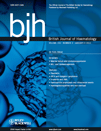Pancreatic iron loading in chronically transfused sickle cell disease is lower than in thalassaemia major
Summary
Iron endocrinopathy and cardiomyopathy are common in chronically transfused thalassaemia major patients, but relatively rare in chronically transfused patients with sickle cell disease. Since magnetic resonance imaging can demonstrate preclinical organ iron deposition, we hypothesized that pancreas and cardiac R2* would likewise be lower in sickle cell disease patients than thalassaemia major patients having comparable transfusional burdens. To test this hypothesis, we examined pancreatic and cardiac iron in a convenience sample of 100 chronically-transfused sickle cell disease and 131 thalassaemia major patients. Cardiac R2* (30 ± 9·2 vs. 73 ± 53 Hz, P < 0·0001) and pancreatic R2* (52 ± 62 vs. 253 ± 224 Hz, P < 0·0001) were significantly lower in sickle cell disease than thalassaemia major. Liver iron concentration was similar in both groups (14·9 ± 9·8 vs. 12·3 ± 8·4 mg/g dry weight, P = 0·101). The observed disparity in pancreatic and cardiac iron loading between sickle cell disease and thalassaemia major patients mirrors prior observations of organ toxicity in these patients. Greater cumulative transfusional iron exposure in thalassaemia major patients partially explains these observations but our data also suggest innate differences in labile iron handling between the two diseases.




